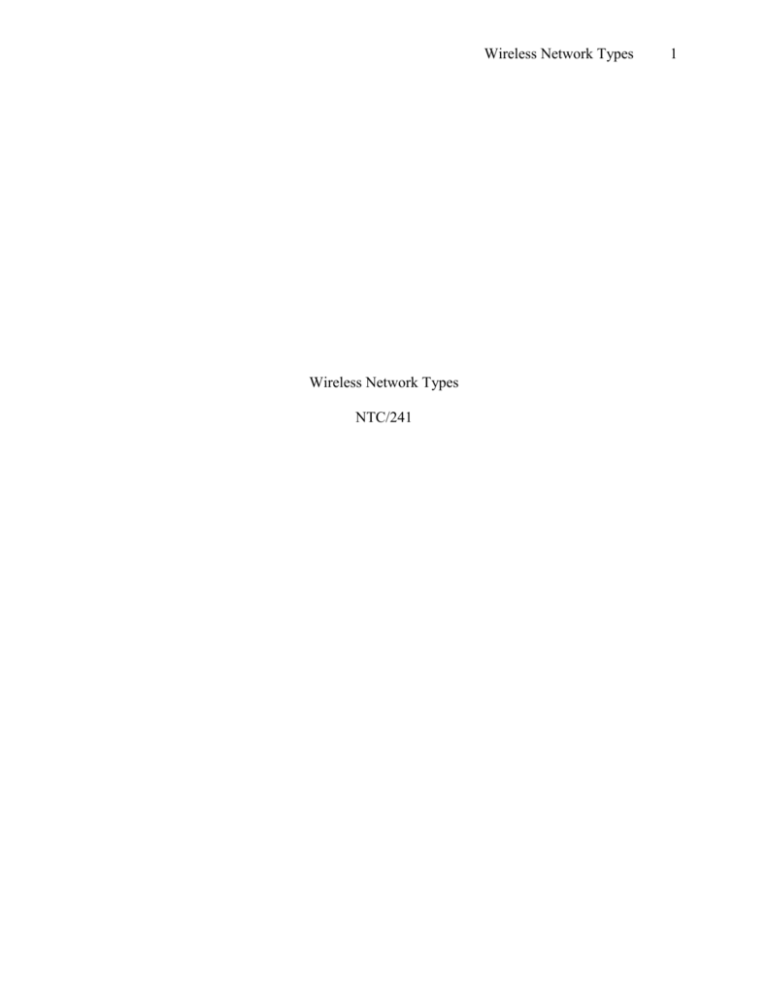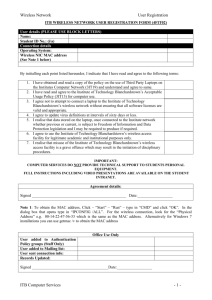Wireless Network Types 1 Wireless Network Types NTC/241
advertisement

Wireless Network Types Wireless Network Types NTC/241 1 Wireless Network Types 2 Wireless Personal Area Network (WPAN) Maximum transmission distance The upper limit of transmission distance of a wireless personal area network is relatively associated to the kind of WPAN employed. In reference to Kioskea.net (2008), Bluetooth has a transmission distance of more or less 30m, HomeRF has a transmission distance of 50-100m if an amp is not used, while ZigBee, also called IEEE 802.15.4, has a transmission distance of approximately 100m. Two current applications of WPANs 1. WPANs are used to link 2 Wi-Fi apparatus together, like the receiver and base of a wireless telephone. 2. WPANs are used for Bluetooth technology for mobile phone, keyboard, mouse, etc. Research WPAN networks and list one A potential application of this is the Ultra Wide Band future use of this technology. (UWB) technology by WiMedia. According to EE Times India (2008), this technology is known to decrease energy usage and improve throughput. In addition, it is unaltered by other wireless networks in the vicinity in the equivalent band. Wireless Network Types 3 o Wireless Metropolitan Area Network (WMAN) Maximum transmission distance The upper limit of transmission distance of a WMAN can be different. In reference to Kioskea.net (2008), Wi-Fi can be broadcasted at more than a hundred meters, and HiperLAN2 (European standard) is broadcasted at around 100m. The latest standard 802.11n can be broadcasted at more than 160m. Two current applications of WLANs 1. Wireless Local Area Networks are utilized in houses and offices throughout the whole world to enable data and allocating internet connection. 2. Some medical centers employ Wireless Local Area Networks to communicate with cordless handheld equipment. Research WLAN networks and list one Several end-users and offices employ Wireless Local future use of this technology. Area Networks and because of the rise of IP communication devices and businesses providing these services, a lot of consumers are replacing their traditional communication devices to Voice Over Internet Protocol (VOIP) devices and use the Internet to transmit and receive voice data. Some end-users and companies do not opt to change at the moment because of irregularity of Voice Over Internet Protocol (VOIP). Wireless Network Types 4 o Wireless Metropolitan Area Network (WMAN) Maximum transmission distance In reference to Kioskea.net (2008), Wireless Metropolitan Area Network has a maximum transmission distance of about 4-10km. Two current applications of WMANs 1. Wireless Metropolitan Area Network are at present applied as a backhaul connecting two local wireless networks (Kioskea.net, 2008). 2. Wireless Metropolitan Area Networks are also utilized to enable faster Internet connection where standard cable connection is not available (Kioskea.net, 2008). Research WMAN networks and list one An outlook for the Wireless Metropolitan Area Network future use of this technology. is the WiMax, a 802.16 standard. According to Kioskea.net (2008), by using $20-thousand (or higher) base stations, it can ultimately replace cabled networks in offices and college grounds. Also, it can broadcast at the rate of 70 megabytes per second and distance of 30mi. WiMax can provide end-users and offices that cannot obtain connection to the Internet to have a network that is probably more efficient than wired networks or DSL. Wireless Network Types 5 Wireless Wide Area Network (WWAN) Maximum transmission distance It seems that there are no boundaries with regard to the transmission distance of Wireless Wide Area Network. Mobile phones and satellite phones are simply restricted to signal strength which fluctuates according to the environment. Two current applications of WWANs 1. It is currently used for digital mobile phones. 2. It is also utilized for broadcasting via satellite. Several GPS service provider apply WWAN to connect GPS coordinates. Research WWAN networks and list one An outlook on the application of WWAN in the near future use of this technology. future is 3G and 4G wireless technology. Users have been very reliant on the World Wide Web for their email, social networking, etc. that there appears to be an increased requirement for wireless equipment that have the capability to operate at any place. It is similar to the case in the past in terms of the functions of the mobile phones; users expect and required mobile phones that they can use anywhere, so about 37 years after their development, these gadgets are capable of being used at any and every place. Wireless Network Types 6 References [1] Kioskea.net (2008). Wireless Networks. Retrieved from http://en.kioskea.net/contents/wireless/wlintro.php3# [2] EE Times India (2008). Using WiMedia UWB Technology to Enable Future-Generation WPANs. Retrieved from http://www.eetindia.co.in/ARTICLES/2008FEB/PDF/EEIOL_2008FEB12_RFD_SIG_N ETD_TA_09.pdf?SOURCES=DOWNLOAD






